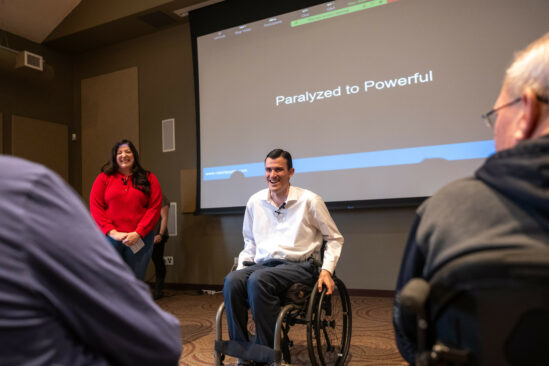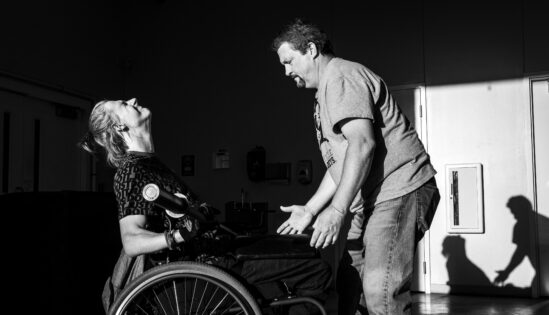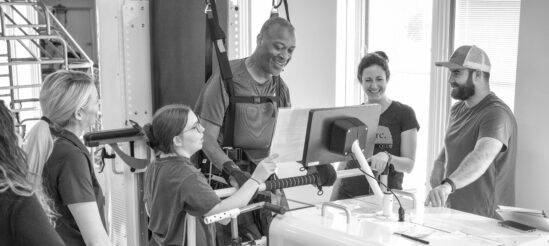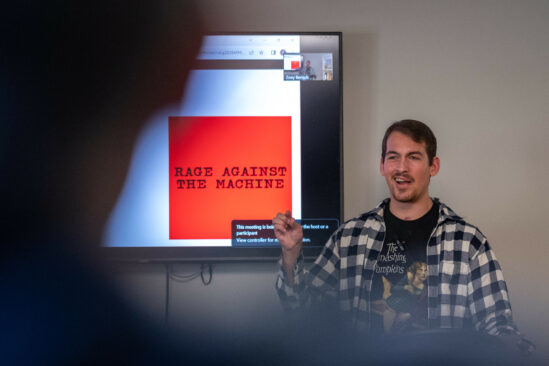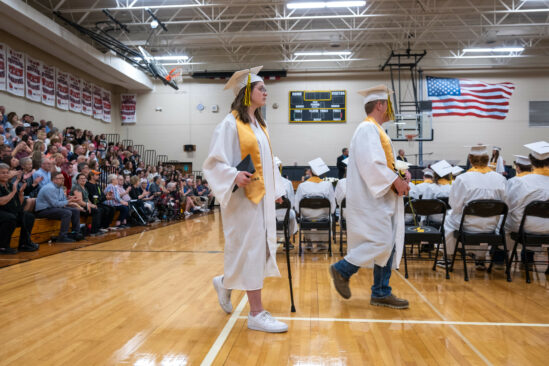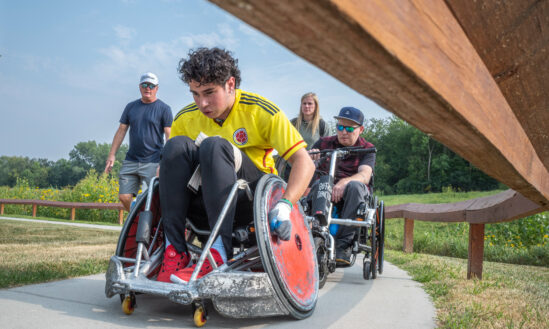Danny Bradshaw pilots his powered wheelchair to the open driver’s side door. It’s a mild mid-January day on QLI’s campus, a day whose overcast sky and melting snow will provide the right circumstances for an afternoon of training behind the wheel.
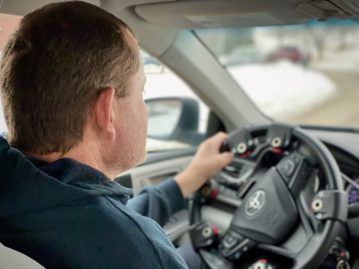 This will be only the second time Bradshaw has operated a motor vehicle since suffering a spinal cord injury in November. Even more daunting—it’s the first time he’ll operate the vehicle on public roads away from the relative predictability of QLI’s secluded campus loop.
This will be only the second time Bradshaw has operated a motor vehicle since suffering a spinal cord injury in November. Even more daunting—it’s the first time he’ll operate the vehicle on public roads away from the relative predictability of QLI’s secluded campus loop.
Bradshaw is unperturbed. Part of that speaks to his natural calm. The 49-year-old from north central Iowa applies a workmanlike focus to all the moving parts of his rehabilitation. Recovery, like anything, is a process of elimination. Go with what works, find out what doesn’t, put in the time to fill the gaps.
It helps that the drive itself is designed for success. Bradshaw will bring a passenger in tow—Erin Young, an occupational therapist at QLI and the specialist leading the organization’s adaptive driving program. Furthermore, the car itself, a Toyota Camry, carries within its chassis more than meets the eye: adaptive modifications to nearly every operational system. Steering assists, throttle controls, headlights and turn signals, safety features. You name it, and it’s been engineered for accessibility.
For Bradshaw, who quietly boosts himself from the cushion of his wheelchair to the driver’s seat of the car, the key modification today is a left-footed accelerator pedal.
“Since Danny is still dealing with weakness and a lack of sensation on his right side,” Young explains, “a left-sided pedal gives him the freedom to operate the vehicle normally.”
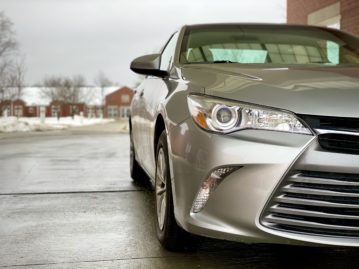 The sedan is the newest piece of QLI’s ever-expanding adaptive driving arsenal, a sister vehicle to a universally accessible van the organization has used since 2016. While the van represents the model for high-tech driving modifications more suitable for those recovering from injuries of greater severity, QLI’s new sedan offers a different approach for adaptive drivers. Every addition to the car is in some way modular and, ultimately, configurable to its respective user.
The sedan is the newest piece of QLI’s ever-expanding adaptive driving arsenal, a sister vehicle to a universally accessible van the organization has used since 2016. While the van represents the model for high-tech driving modifications more suitable for those recovering from injuries of greater severity, QLI’s new sedan offers a different approach for adaptive drivers. Every addition to the car is in some way modular and, ultimately, configurable to its respective user.
“Not every driver is going to need the support of advanced technology,” says Young. “The sedan allows us to identify the baseline of what’s appropriate. That provides crucial information to us as clinicians as we find the best way to set someone up for their future driving.”
Each piece of technology in the sedan—including the purchase price of the part itself and the cost of its installation—comes to QLI thanks to a generous gift from Mobility Motoring, an accessible transportation supplier based in Omaha, Nebraska. Working with Sure Grip and Guidosimplex, specialized manufacturers of adaptive hand controls, Mobility Motoring acquired a suite of modifications for QLI’s new vehicle.
As Young explains, there is no one-size-fits-all solution for adaptive drivers. No two injuries are alike, which means no two adaptive driving approaches will be entirely similar. As a result, the technology donated to QLI accounts for a spectrum of needs.
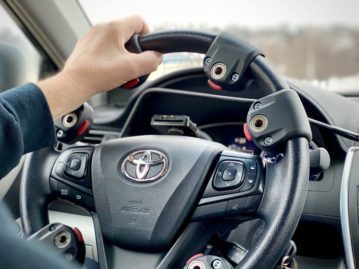 Wheel-mounted knobs and spinners give those with reduced hand function the means to steer the vehicle. A hand-operated “Push / Rock” device transfers throttle control from the pedals to a lever system just underneath the wheel. An “Over-Ring” acceleration system affixes to the steering wheel like a halo, marrying steering and throttle control together with an intuitive single action.
Wheel-mounted knobs and spinners give those with reduced hand function the means to steer the vehicle. A hand-operated “Push / Rock” device transfers throttle control from the pedals to a lever system just underneath the wheel. An “Over-Ring” acceleration system affixes to the steering wheel like a halo, marrying steering and throttle control together with an intuitive single action.
The technology isn’t just forward-thinking automotive science. It’s a lifeline for drivers like Bradshaw looking to reclaim independence.
Young accompanies Bradshaw through a pre-drive check, ensuring the mirrors cover his blind spots, the steering wheel and driver’s seat support a good posture, and his left foot doesn’t rest on both the modified accelerator and the brake pedal simultaneously.
Everything passes inspection. Bradshaw, with Young in the passenger seat, sets off.
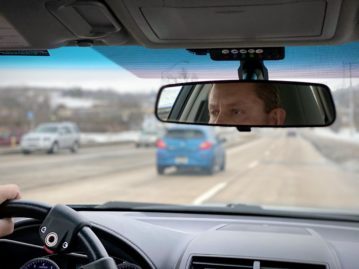 The drive, like Bradshaw, is calm. Steady. There’s an ease with which he presses on the throttle and a confidence to the way he brings the car to a stop at intersections and red lights. If it weren’t for the “Student Driver” sticker pressed onto the back of the car and Young’s occasional directions, one might not realize there was anything unique about this drive at all.
The drive, like Bradshaw, is calm. Steady. There’s an ease with which he presses on the throttle and a confidence to the way he brings the car to a stop at intersections and red lights. If it weren’t for the “Student Driver” sticker pressed onto the back of the car and Young’s occasional directions, one might not realize there was anything unique about this drive at all.
“It’s an adjustment getting used to the speed of a car,” Bradshaw says. “The fastest I’ve gone in a wheelchair is two miles-per-hour.” He laughs, again showcasing how easily this has become a successful drive.
Bradshaw will continue training in QLI’s sedan. Driving on Omaha’s busy downtown streets. Eventually, even sessions on the interstate to emulate the roads he’ll frequent in central Iowa. He’s only the first of what will surely be a long list of individuals reconnected to independent driving thanks to the expertise of QLI and the generously donated technology in this car.
But for now, as he begins his return trip to campus, he has a special request for Young. He asks to stop at a drive-through. She agrees immediately, recognizing it as a real-world precision test for his use of the left-foot accelerator.
“Great,” he says. “Because I could go for a Coke.”





